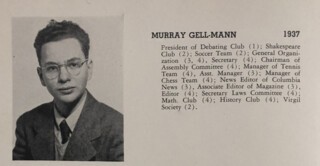‘Stick with me, kid’
Jeremy Bernstein remembers Murray Gell-Mann
In the spring of 1959 I won a National Science Foundation fellowship that enabled me to do physics anywhere I wanted to. I chose Paris. I had spent the last couple of years at the Institute for Advanced Study in Princeton and wanted very much to go to a city. Murray Gell-Mann was paying a visit to Princeton at the time. I had written a paper with a colleague suggesting how an idea of Gell-Mann’s could be tested experimentally. He dropped round to my office and asked what I was doing the following year. I told him. To my surprise he said he was going to Paris too, and added: ‘Stick with me, kid, and I’ll put you on Broadway.’ I didn’t then tell him that I was familiar with him from another life.
In the 1940s we had gone to the same private high school – Columbia Grammar – in New York. As I write this I am looking at Murray’s picture from the 1944 yearbook. He was a senior and I was a freshman although he was only a couple of months older. Murray was 15 and had already been accepted at Yale. He was valedictorian of his class but wasn’t voted the most likely to succeed.
I don’t have the impression that Murray was a great success at Yale. He majored in physics but decided not to do the senior thesis he was assigned to. When he applied to graduate school the physics department wouldn’t have him. He couldn’t get any scholarship help from Harvard or Princeton so ended up at MIT, as an assistant to Victor Weisskopf, who had the intellect and the broad sense of humour to deal with him. Murray wrote a thesis with original work which he did not bother to publish. Weisskopf got him into the Institute in Princeton in 1952.
He shared an office with Francis Low. Francis was several years older than Murray but he too had just got his PhD (being in the Ski Troops and fighting in Italy had delayed his studies). Francis once told me that he had found this ‘child’ in his office. Murray was already something of a terror, monopolising colloquia and the like. Francis was a ready match for Murray intellectually and the two of them collaborated on papers that resound to the present day.
After teaching at Columbia and Chicago, Murray moved to Caltech in 1955. He did the work that I wrote a paper on there in collaboration with Richard Feynman. Now he turned his attention to the new particles that kept appearing in cosmic radiation. They seemed to make no sense. It was an obsession with Murray to bring some order to all of this. While he was in Paris he was struggling with it. It was only when he got back to Caltech that a mathematician explained to him what he had been trying to do and it all seemed to fit together. He predicted the existence of a particle that he called the quark (a reference to Finnegans Wake: ‘three quarks for Muster Mark’ – the nuclear particles are made up of three quarks) and in 1969 won the Nobel Prize.
I got to know Murray and his first wife, Margaret, much better when I began going to the Aspen Center for Physics in the summer. Murray was a charter member and he used some of his Nobel money to buy a house there. They used to hike a lot so Murray could look for birds. Murray was a fanatic bird watcher and went all over the world pursuing them. When I met him on a trail he would always ask me if I had seen any interesting birds. I would always tell him that I had seen a little grey one. Margaret died of cancer in 1981. In recent years Murray had been quite ill with some form of Parkinson’s. He lived long enough to be told that a particle had been observed made of five quarks just as he had predicted. He died on 24 May, aged 89.

Comments
He was obviously immensely clever, but in that book he also came across as wise.